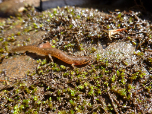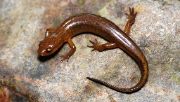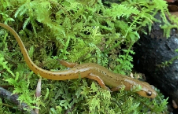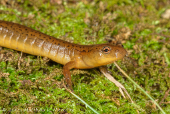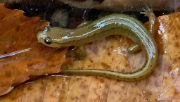Junaluska Salamander (Eurycea junaluska)
Description: Eurycea junaluska has a brownish dorsum with small dots or wavy lines along the body. An easy way to distinguish E. junaluska from E. bislineata is E. junaluska has a more robust body, longer forelimbs, and a shorter tail. Also, Sever and his colleagues studied the teeth series and discovered E. junaluska possesses a longer prevomerine teeth series. In addition to these traits, a wavy, broken, black stripe up to 0.80 mm wide extends from the nostril through the eye and through the sides of the body and tail. The front limbs contain four toes and the back limbs contain five toes. Nasolabial grooves are present and the number of coastal grooves usually ranges from 13 to 15.
Habitat: This species has been found to be most active during warm, rainy nights in early spring near creeks, on streambanks, and in streams. Adults are commonly found in streams during colder months and in forests surrounding the streams during warmer months. Within streams, both adults and juveniles have been observed to hide beneath large, flat rocks in regions of shallow water and moderate stream flow. It does not tolerate alterations to stream habitats. This species is thought to breed by larval development, as with congeners.
Range: Junaluska salamanders have only been found in the Blue Ridge Mountain area in the Cheoah River, Santeetlah Creek, and Tululah Creek in Graham County of North Carolina. They are also found in a limited number of creeks in the Great Smoky Mountains National Park, Sevier County, Tennessee. These salamanders are very rarely encountered in either area. One looking for this species is more likely to find E. junaluska in larger rocky streams in colder weather.
Found in these States:
NC |
TN
Diet: The Junaluska salamander is thought to feed on smaller invertebrates found in the stream and forest areas they inhabit.
Reproduction: The larval life history of E. junaluska is still not very well known. Studies have found the breeding season is spread from fall to early spring. The larval period reportedly lasts around two to three years, and metamorphosis occurs during the summer months. Eggs are laid in the streams and are attached under media such as large rocks. The depth of the eggs laid range from 6 to 20 cm. The adult salamanders stay around where the eggs are laid to protect the egg clutch. Clutch sizes range from 30 to 50 eggs. The larvae are completely aquatic until they metamorphose into adults.
Status: Listed as Vulnerable because its extent of occurrence (EOO) is 5,537 km2, it occurs in 10 or fewer threat-defined locations, and there is continuing decline in the extent and quality of its habitat in south-western North Carolina and south-eastern Tennessee, USA.
Taxonomy: The specific name Junaluska was chosen to honor a Cherokee chief who was prominent in North Carolina's history, Junaluska. The area Chief Junaluska was given contains a good amount of the range of where the species exists in North Carolina, which is the reason for the naming of the salamander.
»» Kingdom: Animalia - Animals
»» Phylum: Chordata - Chordates
»» Subphylum: Vertebrata - Vertebrates
»» Class: Amphibia - (Amphibians)
»» Order: Caudata - Salamanders
»» Family: Plethodontidae - Lungless Salamanders
»» Genus: Eurycea
»» Species: Eurycea junaluska - Junaluska Salamander
This article uses material from the Wikipedia article "Junaluska Salamander", which is released under the Creative Commons Attribution-Share-Alike License 3.0. Content may have been omitted from the original, but no content has been changed or extended.
|



